These 7 Indie Authors Face Breast Cancer With Bravery, Strength, and Wit
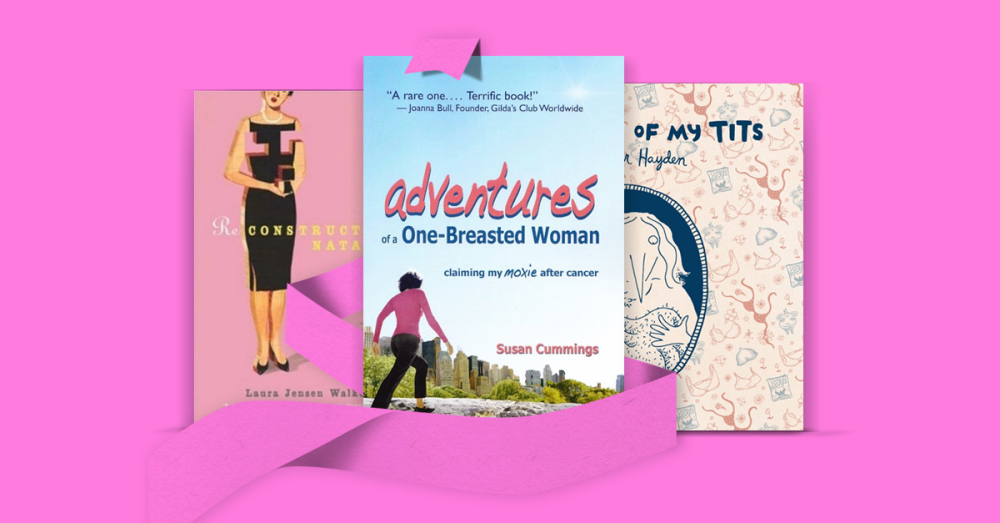
Since one in eight US women (about 12 percent) will develop invasive breast cancer over the course of her lifetime, it is little wonder that many authors have dealt with the topic eloquently. For Breast Cancer Awareness Month, we’re highlighting some of the best independently published books on the topic. These women face breast cancer in different ways: some with sorrow and mourning, others with a stiff upper lip and a brave face, and others with bitter humor and dark wit. Read their stories and borrow some of their strength, or pick a how-to guide to get through a trying time.
The Story of My Tits
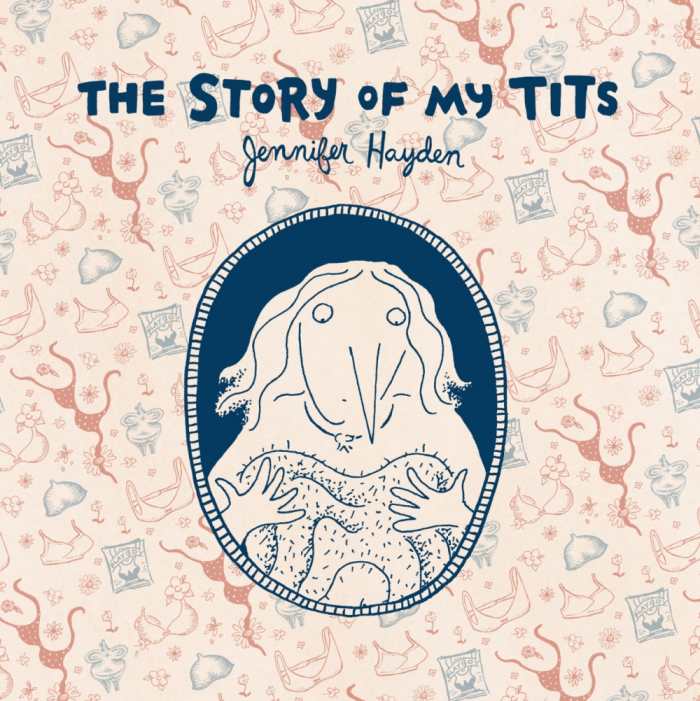
Jennifer Hayden
Top Shelf Productions
Softcover $29.99 (352pp)
978-1-60309-054-4
Buy: Local Bookstore (Bookshop), Amazon
In this fabulous memoir, Hayden traces her coming of age in terms of her breasts, from flat-chested adolescence to motherhood to breast cancer and a double mastectomy, taking readers full circle into her second life. For a story that cancer twines through (Hayden’s mom and mother-in-law both had cancer as well), it is delightfully hilarious. Hayden has a gift for slowly building up the emotion until you’re crying and then flipping it in the very next panel, so you’re suddenly laughing. Make no mistake, this isn’t just breast-cancer memoir, it’s a true story of growing up: of discovering parents are fallible, of negotiating relationships and dealing with that complicated time when it seems everyone’s getting married and having babies except you, of discovering what it is you want to do with your life. In the epilogue, Hayden is just starting to do comics and worries that she won’t be good enough. Nine years and several comics later, it’s pretty clear she has the right stuff.
ALLYCE AMIDON (August 27, 2015)
Adventures of a One-Breasted Woman
Reclaiming My Moxie after Cancer
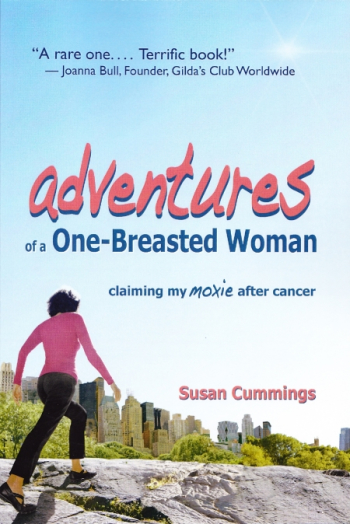
Susan Cummings
Booksmyth Press
Softcover $12.95 (175pp)
978-0-9815830-7-5
Buy: Local Bookstore (Bookshop), Amazon
By her early forties, Susan Cummings had compiled an eclectic resume: a stint teaching in Cairo, a period in Paris, years acting on stage in Manhattan. She had also discovered a calcification in her breast. A mastectomy removed the immediate threat, but that flirtation with her mortality was real enough to confuse Cummings’ comforts and convictions. What did she really want out of the rest of her life, and how could she achieve it?
Its pages both mirthful and forthright, Cummings’ memoir walks readers through a cancer survivor’s stages of acceptance. The journey involves expected emotions, like anger, explored deftly in a chapter in which Cummings pens aggressive letters to all those frustrating and disappointing her, from flaky doctors to errant health food stores. “Wake up and smell the miso!” she rages when a purportedly macrobiotic purveyor slips margarine into the baked goods. Cummings also finds herself employing other coping mechanisms, including a whirlwind search for alternative health-care options that involves downing homeopathic pills and dubious elixirs.
Cummings confronts, and demolishes, conventional explanations for why cancer happens, all of them laden with victim-shaming and none of them ultimately helpful. She also wryly relates the neuroses that arise when a single frightening diagnosis makes one aware of the breadth of other possible scary diagnoses. These reactions are sometimes moribund, sometimes absurd, and sometimes frenetic, but they are always wholly human and sympathetic.
The book is poised to resonate with those who have shared Cummings’ health concerns and with women in general, as body image issues are a recurrent theme. The author recalls a lifetime of small-breastedness prior to her one-breastedness, and her ultimate decision to forgo artificiality is a bold one. Pages that meditate on the beauty of asymmetry are particularly powerful, as are recollections of the way friendships develop, deepen, or crumble when health scares are added to their mix.
A bit of statuary, stumbled upon during a hike undertaken to distract, depicts a woman’s hands crossed over her breasts; this becomes the vehicle by which Cummings explores new questions of spirituality with both poignancy and some hilarity. “Grace happens all the time, dear,” God assures her in an internal dialogue, one which also includes a cheerful reminder that Cummings may remain in remission and still be susceptible to lightning strikes and choking on chicken bones. The author’s previous regrets become a site from which she reinvents, and reinvigorates, her life. Ultimately, a diagnosis which made Cummings reflect that she ought to have danced more isn’t a hopeless one; it prompts her to do precisely that, and more, with transformative results.
Readers will be charmed and inspired as Cummings reconciles herself to, and situates herself in, a post-cancer life. Her revelations are often intimate, and her willingness to explore family and personal disappointments and forgiveness lend the project affecting power. The triumphs of the book’s final pages are a welcome rebirth which perfectly punctuate this celebratory work.
MICHELLE ANNE SCHINGLER (March 19, 2013)
Reconstructing Natalie

Laura Jensen Walker
West Bow Press
Unknown $14.99 (320pp)
978-1-59554-067-6
Buy: Local Bookstore (Bookshop), Amazon
Cancer is no laughing matter—except when it is, says the author in her latest novel. As a breast cancer survivor herself, Walker, a chick lit writer (Dreaming in Black and White; Dreaming in Technicolor) translates her own experience into a poignant story about a young woman dealing with a potentially life-threatening disease.
It’s far from funny when twenty-seven-year-old Natalie Moore is diagnosed with breast cancer. Still in the prime of her life, she finds herself haunted—not simply by the fear of dying. As an evangelical Christian, she feels certain that she’ll be saved and welcomed into “the arms of Jesus” should she die, but she’s just as concerned about the here-and-now lack of a boyfriend’s or husband’s arms in which to seek comfort as she confronts her mortality.
It’s a natural and normal reaction for a young woman struck by a possibly-terminal illness. The telling of the story, too, is natural, as it perfectly captures a rapid-fire alternation between tragedy and hilarity. One moment, Natalie is sobbing on the shoulder of her neighbor, Andy, wailing, “‘I don’t want to die,’” and the next, she’s hysterically laughing about a series of breast-related puns her friends are making (”‘Happy Boob-Voyage!’” they wish her on the eve of her voluntary double mastectomy).
It’s a difficult journey, but—fortunately—Natalie doesn’t have to make it alone, as she is assisted by the eclectic group of women in her support group and by her two close girlfriends. Helpful, too, is that neighbor, Andy—a childhood best friend (or maybe more?, Natalie wonders) who lives next door, nursing a broken heart (his wife picked up and left one day after “deciding the white-picket-fence-and-mother-in-the-suburbs bit wasn’t for her”) and raising his young son.
Natalie is a delightful narrator, doling out vivid and humorous descriptions of her friends. She says of one free-spirited, bohemian pal, “She’s a modern day Annie Hall. (Or Mary Kate Olsen with a little more padding. But don’t ever tell her I said so).” Natalie’s penchant for pop culture (the Olsen twin reference is followed quickly by an in-depth analysis of the Ross/Rachel relationship on Friends) is a chirpy foil to the book’s darker sections about Natalie’s battle with depression, and the author deftly skips between humor and sadness.
Though the voyage from cancer victim to survivor is central to the plot, the book is much larger than that. It’s also about Natalie’s growth from girl to woman and about her journey to a more complete life and a fuller spirit. But, mostly, it’s a touching and realistic story about the precious lifeboats—friends, family, and faith—that keep everyone afloat in life’s choppy waters.
Yoga for Breast Care
What Every Woman Needs to Know
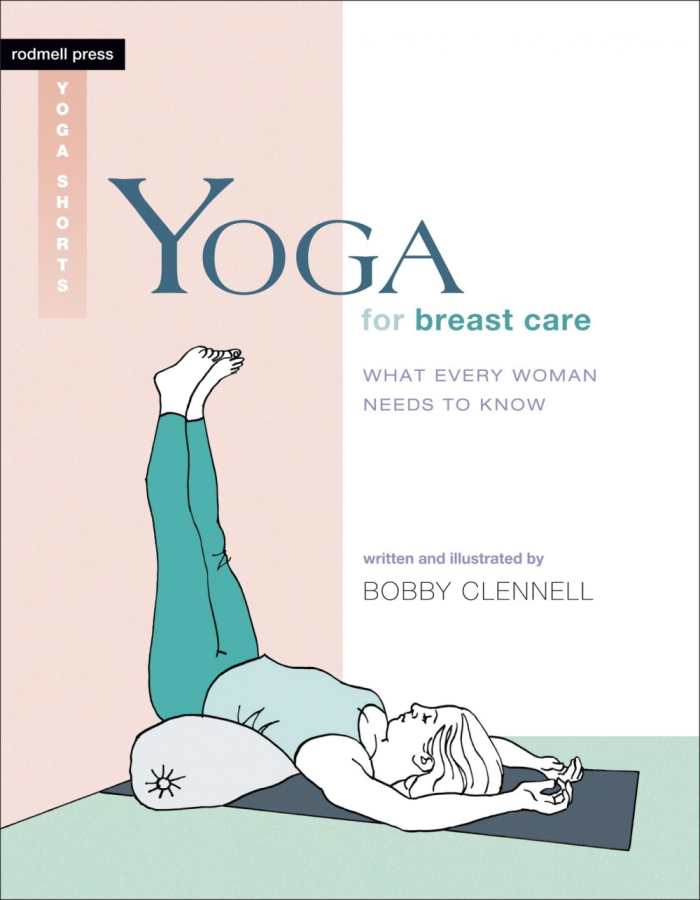
Bobby Clennell
Rodmell Press
Softcover $16.95 (168pp)
978-1-930485-33-4
Buy: Local Bookstore (Bookshop), Amazon
Designed specifically for women’s health, this important book is accessible for even beginning yogis.
Bobby Clennell brings knowledge of breast health to women at all stages of adult life in Yoga for Breast Care: What Every Woman Needs to Know. Clennell’s clearly written narrative and helpful illustrations enhance this important book for women.
The breast-health concerns discussed by Clennell include fibrocystic breast condition, pregnancy, breastfeeding, menopause, and breast cancer. She describes poses that can help reduce symptoms of these conditions and promote overall breast health. Sequences of ten or so poses are designed for specific purposes, such as building breast immunity and energy, stages of pregnancy, nursing mothers, lessening effects of breast-cancer treatment, and relaxation. Poses can be adapted to individual physical constraints and are appropriate for women at all levels of yoga experience. A longtime teacher of Iyengar style yoga, Clennell learned the traditional female perspective of yoga from Geeta S. Iyengar.
Divided into five parts, the book’s third section describes selected yoga poses. Clennell excels at explaining the explicit details of a pose that ensure its correct execution for those learning without a teacher. For Hero Pose (a seated asana), she writes, “Use your hands to ease your calf muscles outward and away from the backs of your knees so when you sit, the inner side of each calf touches the outer side of each thigh.”
Knowledge of how yoga poses affect the body is another important aspect that Clennell addresses at the beginning of each yoga sequence. For the series of poses to build strong immune response, she explains, “The breasts move when extending and when jumping in and out of the poses, so lymph flow is stimulated, and breast and armpit tissue is toned.”
Clennell’s direct writing style offers comforting reassurance to allay possible embarrassment about considering the intimate subject. Her simply rendered illustrations reflect that empathy while showing correct body alignment for poses and recommended props and variations. Health contraindications for certain poses, and ways in which poses benefit specific parts of the body, enhance the narrative. A helpful glossary of terms, list of resources, and index conclude the book.
MARGARET CULLISON (February 27, 2015)
Stand by Her
A Breast Cancer Guide for Men
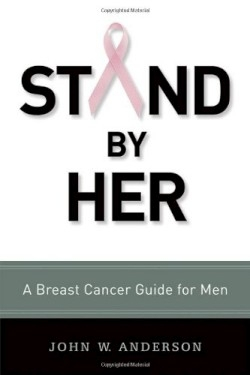
John W. Anderson
AMACOM Books
Softcover $18.95 (272pp)
978-0-8144-1391-3
Buy: Amazon
This is essentially a how-to book for men—more specifically, a what-to-do, how-to-do-it, and why-it’s-important book, with a lot of emphasis on the importance of empathy and understanding. The author, John W. Anderson, a writer and director, is well suited for the role he chose to fill as a caregiver for his mother, wife, sister, and a close friend in their individual struggles with breast cancer. His experience has made him particularly sensitive to the attendant fears and insecurities unique to this disease, and to the pressures of being counted on for support.
An important element in fighting breast cancer is the “will to win,” even when the odds seem overwhelm-ing. Anderson’s sister Mary, a devout Catholic who prayed to the Virgin Mary, credits faith for getting her through her battle with breast cancer. His mother prayed to St. John Neumann, whose shrine was a short drive from her home. His wife, however, found the help she needed in Reiki, a Japanese technique for stress reduction and relaxation that is also said to promote healing through spiritually guided life-force energy.
Caregivers should consider ways of reducing their own stress, a point Anderson makes in a startling confession related to a Canadian getaway at a time when his wife felt up to the trip. Writing of his unexpected breakdown, he says, “I couldn’t take it any longer. I had flat-lined.”
Among the post-op challenges for couples, one of the biggest is the sexual standoff. She wants him to make the first move because it will make her feel that she is still desirable. He, on the other hand, doesn’t want to seem pushy. Talking to each other would seem to be a step in the right direction, but who starts the conversation?
Such candor as one finds here, along with page after page of sound practical advice and empathic counsel for every stage of this fearsome disease, make Anderson’s book an undisputable choice for a place on the shortlist of guides for caregivers.
HAROLD CORDRY (August 16, 2009)
In the Mirror

Kaira Rouda
Real You Publishing Group
Softcover $15.00 (300pp)
978-0-9849151-6-3
Buy: Local Bookstore (Bookshop), Amazon
Balancing sadness and humor, the retrospective tone of this novel is both therapeutic and affecting.
In the Mirror by Kaira Rouda is an emotion-packed novel about a mother facing terminal cancer. It is a nostalgic tribute to the things that really matter: family and friends.
Jennifer, the protagonist, is diagnosed with breast cancer right after her daughter’s birth. The story, told from her perspective, shows how her illness deepens her appreciation for her husband, son, and daughter. Cancer is the main antagonist of the story, but a surprise encounter with an old flame also complicates the plot, upping the stakes for Jennifer and her family.
The story opens with Jennifer insisting on planning a party for herself, a sort of predeath funeral, as an outlet for her grief and gallows humor. Her planning propels her and keeps the story balanced between laughter and pathos. Humor is vital to keeping the book from being too painful and sentimental. Each chapter opens with a warning that mimics a medication label and foreshadows the events of the chapter; for example, “Warning: Intentional misuse can be harmful.”
One of the strongest parts of the book is Jennifer’s friendship with Ralph, another patient in treatment at Shady Valley, “a special all-suite, last-ditch-effort experimental facility for the sick and dying.” Their relationship is endearing, as they face the loneliness of illness with heart and sarcasm. Relationships are the book’s central focus. This low-action, minimal-exposition approach keeps the novel concentrated on the dizzyingly intense mix of humor, pain, and love that Jennifer feels.
Jennifer’s first-person voice portrays the stress and confusion of her situation, keeping readers close to the emotion of the narrative. While Jennifer is a reliable narrator, her limited, stress-fueled perspective is wearying and restricting at times. It’s hard to go through the pain and sickness with her and feel trapped in her mind while she’s making mistakes.
The tone of the book is wholly retrospective, even when detailing present action—echoing Jennifer’s view on life. The title and cover image (a woman looking in a rearview mirror) prepare readers for this backward look. The tone and imagery are fitting, but they don’t give readers much room to hope for Jennifer’s recovery. As a result, the tension doesn’t grow throughout the book; conflicts unfold and resolve, but the real problems—cancer and death—are already so dire at the beginning of the book that there’s no real suspense.
This novel is a perfect fit for readers who find a good cry to be therapeutic. The ache of the novel will be too much for many who’ve suffered the loss of loved ones, but for those who are in pain, who need a voice to echo what they feel, Jennifer has the feel of a friend.
MELISSA WUSKE (February 19, 2014)
No One Chose This Journey
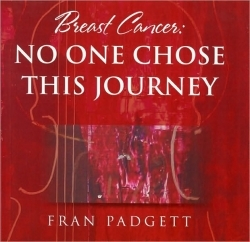
Fran Padgett
Bayou Publishing
Unknown
978-1-886298-33-0
Buy: Amazon
You won’t find the slogan “Hang in there!” or a prominent use of pink in Fran Padgett’s book, Breast Cancer: No One Chose This Journey. These absences are among the strengths of this inspirational book aimed at breast cancer patients.
The core of the book is the narratives of women “chosen by breast cancer,” and of their families and caregivers. Among them is the author’s story of her solo retreat to a resort in Galveston for three days prior to her surgery. Like this story, the others included in this book are not sappy tales of perseverance and suffering; they are simple, straightforward accounts of life’s challenges—work, sickness, survival, and death. The format of each story is unique. For example, Eveline’s story is told through short letters to a friend, and Bonnie’s is a statistical comparison of famous cycling races to her bike ride to her last chemotherapy treatment. The stories are linked by Padgett’s information about the narrators and about her acquisition of the pieces. They are also unified by the theme embodied by Esther Valdez, Mamma Care Specialist. The book is dedicated to Valdez and promotes her mantra, “Care. Share. Be Aware.”
The stories are interrupted by quotes from Robert Frost’s poetry. These excerpts build the metaphor that fighting cancer is like climbing a mountain—a refreshing twist on the journey metaphor. Lyrics from the song “Galveston” and the seventy-four evocative illustrations by the author add dimension to the book. Each work of art was inspired by a specific woman. The final result is an exquisitely presented, glossy volume.
Author and artist Fran Padgett, founder of the Weathervane Foundation, a non-profit dedicated to supporting breast cancer research, received the BMW 2005 Houston Hero Award. Her first book, Breast Cancer Recovery: No One Wrote a Manual, focused on her own experience with breast cancer. In 2007 it was awarded a silver medal in the Independent Book Publishers Association’s Benjamin Franklin Awards.
Padgett has said, “I’ll be a breast cancer survivor when I die of something else. In the meantime, I expect to live every day in every sense of the word.” The book ends with Frost’s poem, “Stopping by Woods on a Snowy Evening,” which is famous for the lines, “But I have promises to keep, / And miles to go before I sleep.” How appropriate.
GERALDINE A. RICHARDS (July 27, 2010)

Hannah Hohman is an editorial assistant at Foreword Reviews. You can contact her at hannah@forewordreviews.com.
Hannah Hohman
